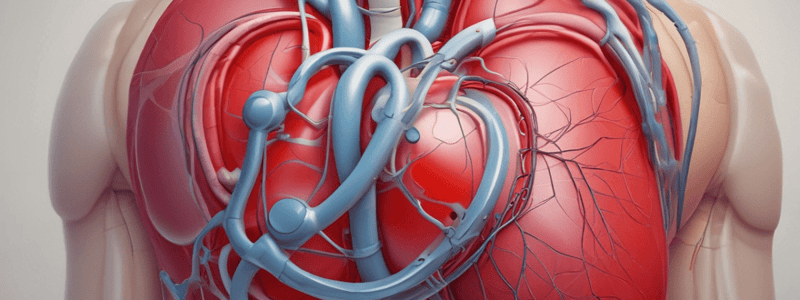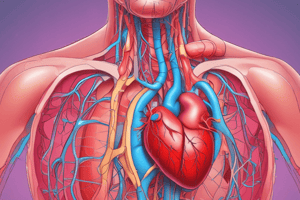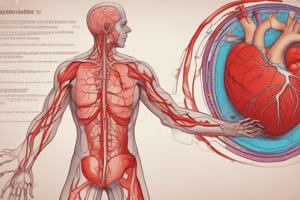Podcast
Questions and Answers
What is the normal range of oxygen saturation in a healthy person?
What is the normal range of oxygen saturation in a healthy person?
- 85-90%
- 90-95%
- 95-100% (correct)
- 100-105%
What is the difference between systolic pressure and diastolic pressure?
What is the difference between systolic pressure and diastolic pressure?
- Systolic is the average pressure, diastolic is the minimum pressure
- Systolic is the pressure during left ventricular contraction, diastolic is the pressure during left ventricular relaxation (correct)
- Systolic is the pressure during left ventricular relaxation, diastolic is the pressure during left ventricular contraction
- Systolic is the minimum pressure, diastolic is the maximum pressure
Where can a pulse oximeter sensor be applied?
Where can a pulse oximeter sensor be applied?
- To the finger, forehead, or earlobe (correct)
- Only to the forehead or earlobe
- Only to the finger
- To the toe or nose
What is pulse pressure?
What is pulse pressure?
What is the minimum mean arterial pressure required to maintain adequate tissue perfusion?
What is the minimum mean arterial pressure required to maintain adequate tissue perfusion?
What is the force that pushes against the arterial walls?
What is the force that pushes against the arterial walls?
What is the normal temperature range in Celsius?
What is the normal temperature range in Celsius?
Which of the following routes of temperature measurement yields a reading 0.5°C higher than oral temperature?
Which of the following routes of temperature measurement yields a reading 0.5°C higher than oral temperature?
What is the average oral temperature in Fahrenheit?
What is the average oral temperature in Fahrenheit?
When assessing pulse, how long should you count for if the rhythm is regular?
When assessing pulse, how long should you count for if the rhythm is regular?
What is the term for a temperature below 36°C (96.8°F)?
What is the term for a temperature below 36°C (96.8°F)?
When palpating peripheral pulse, what part of the fingers should be used to compress the artery?
When palpating peripheral pulse, what part of the fingers should be used to compress the artery?
What is one of the factors that increases blood pressure?
What is one of the factors that increases blood pressure?
Why is it recommended to avoid smoking or drinking caffeinated beverages 30 minutes prior to measuring blood pressure?
Why is it recommended to avoid smoking or drinking caffeinated beverages 30 minutes prior to measuring blood pressure?
What is the correct position of the arm during blood pressure measurement?
What is the correct position of the arm during blood pressure measurement?
What is the purpose of adding 20-30mmHg to the pressure at which the pulse disappears during palpation?
What is the purpose of adding 20-30mmHg to the pressure at which the pulse disappears during palpation?
What is the auscultatory gap?
What is the auscultatory gap?
Why is it important to palpate the brachial artery during blood pressure measurement?
Why is it important to palpate the brachial artery during blood pressure measurement?
What is the correct sequence of steps during blood pressure measurement?
What is the correct sequence of steps during blood pressure measurement?
Why is it important to use the correct size cuff for the patient?
Why is it important to use the correct size cuff for the patient?
Flashcards are hidden until you start studying
Study Notes
Blood Pressure
- Cardiac output, vascular resistance, blood volume, and elasticity of vessel walls all impact blood pressure
- Increased cardiac output, vascular resistance, or blood volume, or decreased elasticity of vessel walls can lead to increased blood pressure
Optimal Conditions for Blood Pressure Measurement
- Avoid smoking or drinking caffeinated beverages 30 minutes prior to measurement
- Ensure a quiet, comfortably warm room
- Patient should be seated quietly in a chair with both feet on the floor for at least 5 minutes
- Arm should be free of clothing
- Use the correct size cuff for the patient
- Palpate the brachial artery, not the radial artery
- Position the arm so that the brachial artery is at heart level
Measurement of Blood Pressure (Part I)
- Determine max inflation pressure by palpating the brachial artery
- Center the cuff over the brachial artery, 2.5cm above the antecubital crease, and secure it snugly
- Palpate the brachial artery while inflating the cuff and note the mmHg when the pulse disappears
- Deflate the cuff, wait 15-30 seconds, and re-inflate to max inflation pressure
Auscultatory Gap
- A period of silence between systolic and diastolic blood pressure that occurs in ~5% of people, often in hypertension
- Caused by a non-compliant arterial system
Measurement of Blood Pressure (Part II)
- Listen for Korotkoff sounds with a stethoscope
- Rapidly inflate the cuff to max inflation pressure, then deflate and listen for sounds
Vital Signs
- Temperature: influenced by diurnal cycle, menstrual cycle, stress, exercise, age, and external temperature
- Routes of temperature measurement: oral, temporal artery, rectal, axillary, and tympanic membrane
- Normal temperature range: 96.8°F to 100.4°F (36°C to 38°C)
Pulse
- Rate: measured by auscultating the apical pulse or palpating the peripheral pulse
- Rhythm: regular or irregular
- Effort: diaphragmatic or thoracic, with or without accessory muscle use
Oxygen Saturation (SpO2)
- Measurement of arterial oxygenation using a pulse oximeter
- Normal SpO2 range: 95-100%
Blood Pressure Terminology
- Systolic pressure (SBP): maximum pressure during left ventricular contraction
- Diastolic pressure (DBP): minimum pressure between left ventricular contractions
- Pulse pressure: difference between SBP and DBP
- Mean arterial pressure (MAP): average pressure forcing blood into tissues over the cardiac cycle, ≥ 60mmHg needed for adequate tissue perfusion
Studying That Suits You
Use AI to generate personalized quizzes and flashcards to suit your learning preferences.




